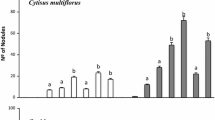Summary
The competition between slow- and fast-growing types of rhizobia for nodulation of cowpeas was studied using modified Leonard-jars. Rhizosphere populations of Rhizobium, mixed and pure populations, were examined on cowpea plants grown in large glass tubes. At 25°C and at a low level of inoculation, the fast-growing strain, NGR 234, dominated the rhizosphere but at 30°C, the slow-growing strain CB 756 dominated or was equally represented depending on its initial level in the mixed inoculum. At 25°C/23°C (day/night), the fast-growing strain from Lablab (NGR 234) was a superior competitor for nodule sites compared with three slow-growing strains of Rhizobium. When plants were grown at 30°/26°C, the slow-growing rhizobia were the better competitors for host nodulation. Fast-growing strains from Mimosa and Leucaena were poor competiors at both temperatures. The results were influenced by the proportions of the competing strains, as well as the total numbers of rhizobia, in the mixed inoculum. Other factors, including ‘host preferences’, host compatibility and time taken for nodule initiation, also contributed to the relative success of competing strains. The results reflect the persistent isolation in tropical regions of slow-growing cowpea-type of rhizobia from most tropical legumes.
Dual occupancy of nodules by both fast- and slow-growing rhizobia occurred in 0–15% of the nodules formed for most paired inocula. However, the fast-growing Leucaena isolate NGR 14/1 was present in 73 to 83% of the nodules formed by the slow-grower CB 756.
Similar content being viewed by others
References
Franco A A and Vincent J M 1976 Competition amongst rhizobial strains for the colonization and nodulation of two tropical legumes Plant and Soil 45, 27–48.
Hardarson G and Jones D G 1979 Effect of temperature on competition amongst strains ofRhizobium trifolii for nodulation of two white clover varieties. Ann. Appl. Biol. 92, 229–236.
Marques Pinto C, Yao P Y and Vincent J M 1974 Nodulating competitiveness amongst strains ofRhizobium meliloti andR. trifolii. Aust. J. Agric. Res. 25, 317–329.
Nicol H and Thornton H G 1941 Competition between related strains of nodule bacteria and its influence on the legume host. Proc. Roy. Soc. (London) B 130, 32–59.
Rolfe B G, Gresshoff P M, Shine J and Vincent J M 1980 Interaction between a non-nodulating and an ineffective mutant ofRhizobium trifolii resulting in effective (nitrogen fixing) nodulation. Appl. Environ. Microbiol. 39, 449–452.
Robinson A C 1969 Competition between effective and ineffective strains ofRhizobium trifolii in the nodulation ofTrifolium subterraneum. Aust. J. Agric. Res. 20, 827–841.
Roughley R J, Bromfield E S P, Pulver E L and Day J M 1980 Competition between species of Rhizobium for nodulation ofGlycine max. Soil Biol. Biochem. 12, 467–470.
Trinick M J 1968 Nodulation of tropical legumes. I. Specificity in the Rhizobium symbioses ofLeucaena leucocephala. Expl. Agric. 4, 243–253.
Trinick M J 1980 Relationships amongst the fast-growing rhizobia ofLablab purpureus, Leucaena leucocephala, Mimosa ssp.,Acacia farnesiana andSesbania grandiflora and their affinities with other rhizobial groups. J. Appl. Bact. 49, 39–53.
Trinick M J 1982 Biology.In Nitrogen Fixation. Vol. 2 Rhizobium. Ed. W Broughton. Oxford University Press.
Trinick M J, Dilworth M J and Grounds M 1976 Factors affecting the reduction of acetylene by root nodules ofLupinus species. New Phytol. 77, 359–370.
Van Rensburg H J and Strijdom B J 1969 Strains ofRhizobium japonicum and inoculant production in South Africa. Phytophylactica 1, 201–204.
Vincent J M and Waters L M 1953 The influence of the host on competition amongst clover root-nodule bacteria. J. Gen. Microbiol. 9, 357–370.
Weber D F and Miller V 1972 Effect of soil temperature onRhizobium japonicum serogroup distribution in soybean nodules. Agron. J. 64 796–798.
Author information
Authors and Affiliations
Rights and permissions
About this article
Cite this article
Trinick, M.J., Rhodes, R.L. & Galbraith, J.H. Competition between fast- and slow-growing tropical legume rhizobia for nodulation ofVigna unguiculata . Plant Soil 73, 105–115 (1983). https://doi.org/10.1007/BF02197760
Received:
Revised:
Issue Date:
DOI: https://doi.org/10.1007/BF02197760




